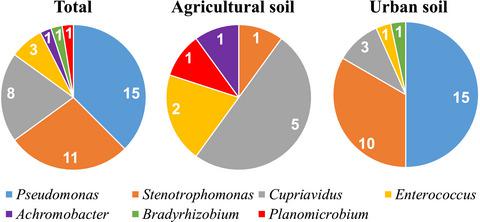当前位置:
X-MOL 学术
›
Microbiologyopen
›
论文详情
Our official English website, www.x-mol.net, welcomes your feedback! (Note: you will need to create a separate account there.)
Urban and agricultural soils in Southern California are a reservoir of carbapenem-resistant bacteria.
MicrobiologyOpen ( IF 3.4 ) Pub Date : 2020-04-03 , DOI: 10.1002/mbo3.1034 Nicolas V Lopez 1 , Cameron J Farsar 1 , Dana E Harmon 1 , Cristian Ruiz 1
MicrobiologyOpen ( IF 3.4 ) Pub Date : 2020-04-03 , DOI: 10.1002/mbo3.1034 Nicolas V Lopez 1 , Cameron J Farsar 1 , Dana E Harmon 1 , Cristian Ruiz 1
Affiliation

|
Carbapenems are last‐resort β‐lactam antibiotics used in healthcare facilities to treat multidrug‐resistant infections. Thus, most studies on identifying and characterizing carbapenem‐resistant bacteria (CRB) have focused on clinical settings. Relatively, little is still known about the distribution and characteristics of CRBs in the environment, and the role of soil as a potential reservoir of CRB in the United States remains unknown. Here, we have surveyed 11 soil samples from 9 different urban or agricultural locations in the Los Angeles–Southern California area to determine the prevalence and characteristics of CRB in these soils. All samples tested contained CRB with a frequency of <10 to 1.3 × 104 cfu per gram of soil, with most agricultural soil samples having a much higher relative frequency of CRB than urban soil samples. Identification and characterization of 40 CRB from these soil samples revealed that most of them were members of the genera Cupriavidus, Pseudomonas, and Stenotrophomonas. Other less prevalent genera identified among our isolated CRB, especially from agricultural soils, included the genera Enterococcus, Bradyrhizobium, Achromobacter, and Planomicrobium. Interestingly, all of these carbapenem‐resistant isolates were also intermediate or resistant to at least 1 noncarbapenem antibiotic. Further characterization of our isolated CRB revealed that 11 Stenotrophomonas, 3 Pseudomonas, 1 Enterococcus, and 1 Bradyrhizobium isolates were carbapenemase producers. Our findings show for the first time that both urban and agricultural soils in Southern California are an underappreciated reservoir of bacteria resistant to carbapenems and other antibiotics, including carbapenemase‐producing CRB.
中文翻译:

南加州的城市和农业土壤是耐碳青霉烯的细菌的库。
碳青霉烯是在医疗机构中用于治疗耐多药感染的最后一种β-内酰胺抗生素。因此,大多数鉴定和鉴定耐碳青霉烯抗性细菌(CRB)的研究都集中在临床环境上。相对而言,关于环境中CRB的分布和特征仍然知之甚少,在美国,土壤作为CRB潜在储藏库的作用仍然未知。在这里,我们调查了洛杉矶-南加州地区9个不同城市或农业地点的11个土壤样品,以确定这些土壤中CRB的发生率和特征。所有测试的样本均包含频率<10至1.3×10 4的CRB 每克土壤cfu,大多数农业土壤样品的CRB相对频率要比城市土壤样品高得多。从这些土壤样品中鉴定和鉴定出40个CRB,表明它们大多数是Cupriavidus,Pseudomonas和Stenotrophomonas属的成员。在我们分离出的CRB中鉴定出的其他较不普遍的属,尤其是从农业土壤中鉴定的属,包括肠球菌,缓生根瘤菌,无色杆菌和疟原虫属。有趣的是,所有这些对碳青霉烯类耐药的菌株也对至少一种非卡巴培南抗生素具有中等或耐药性。对我们分离出的CRB的进一步鉴定显示,分离出11个嗜麦芽单胞菌,3个假单胞菌,1个肠球菌和1个缓生根瘤菌。我们的发现首次表明,南加州的城市和农业土壤均是对碳青霉烯类药物和其他抗生素(包括产生碳青霉烯酶的CRB)耐药的细菌储量不足的地区。
更新日期:2020-04-03
中文翻译:

南加州的城市和农业土壤是耐碳青霉烯的细菌的库。
碳青霉烯是在医疗机构中用于治疗耐多药感染的最后一种β-内酰胺抗生素。因此,大多数鉴定和鉴定耐碳青霉烯抗性细菌(CRB)的研究都集中在临床环境上。相对而言,关于环境中CRB的分布和特征仍然知之甚少,在美国,土壤作为CRB潜在储藏库的作用仍然未知。在这里,我们调查了洛杉矶-南加州地区9个不同城市或农业地点的11个土壤样品,以确定这些土壤中CRB的发生率和特征。所有测试的样本均包含频率<10至1.3×10 4的CRB 每克土壤cfu,大多数农业土壤样品的CRB相对频率要比城市土壤样品高得多。从这些土壤样品中鉴定和鉴定出40个CRB,表明它们大多数是Cupriavidus,Pseudomonas和Stenotrophomonas属的成员。在我们分离出的CRB中鉴定出的其他较不普遍的属,尤其是从农业土壤中鉴定的属,包括肠球菌,缓生根瘤菌,无色杆菌和疟原虫属。有趣的是,所有这些对碳青霉烯类耐药的菌株也对至少一种非卡巴培南抗生素具有中等或耐药性。对我们分离出的CRB的进一步鉴定显示,分离出11个嗜麦芽单胞菌,3个假单胞菌,1个肠球菌和1个缓生根瘤菌。我们的发现首次表明,南加州的城市和农业土壤均是对碳青霉烯类药物和其他抗生素(包括产生碳青霉烯酶的CRB)耐药的细菌储量不足的地区。



























 京公网安备 11010802027423号
京公网安备 11010802027423号